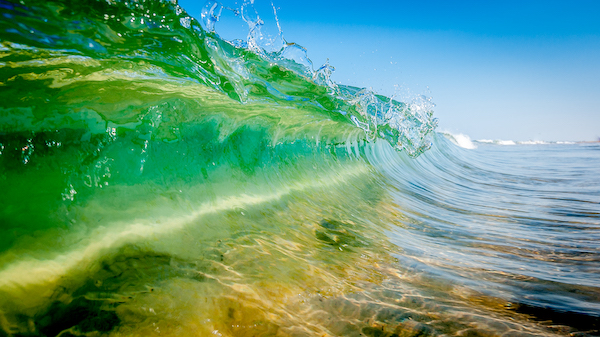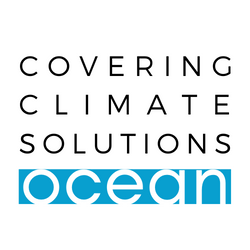SEJournal Online is the digital news magazine of the Society of Environmental Journalists. Learn more about SEJournal Online, including submission, subscription and advertising information.
 |
| As the ocean changes in response to a warming climate, experts see addressing its problem as more critical now than ever. Photo: Guillaume COMMIN, via Flickr Creative Commons (CC BY-NC-ND 2.0). |
Covering Climate Solutions: Reporting Ocean Stories Is Key to Blue Literacy, Planetary Health
By Juli Berwald
When the United Nations declared the 2020s the “Ocean Decade,” it might have seemed like much was about to happen to address global ocean problems and potential as a driver of climate change solutions.
 |
For the first time, in 2019, the Intergovernmental Panel on Climate Change’s Special Report on the Ocean and Cryosphere in a Changing Climate was instrumental in shifting policy, public and journalistic attention to the critical role that the ocean plays in our planet’s climate.
And a raft of ocean-based meetings was set for 2022 (having been postponed because of the COVID-19 pandemic). That included the UN Ocean Conference in Lisbon, just completed in July, which was billed as a wide-ranging meeting whose goal was to exact commitments in support of sustainable development goal 14, Life Below Water.
Yet of all the sustainable development goals (the U.N. in 2015 developed 17 of them as a kind of blueprint for humanity), the ocean SDG remains the least funded, receiving just 0.01% of development finance in 2019 and 0.56% of philanthropic contributions in 2016. The UN Ocean Conference concluded with hundreds of pledges, but the acknowledgment that much remains to be accomplished.
This discrepancy in both funding and action
is emblematic of the ocean beat, which has
received less attention than it deserves.
This discrepancy in both funding and action is emblematic of the ocean beat, which has received less attention than it deserves. It’s a circular problem: Because of lack of attention, the ocean is rife with problems and scarce on solutions, which can make finding stories, reporting them and convincing editors that an ocean story is worth telling a heavy lift.
But as the ocean changes in response to a warming climate, it is work that experts see as more critical now than ever. One conclusion from UN Ocean 2022: Bolstering ocean literacy is key to planetary health.
So here’s a primer on some of the key climate change-ocean connections and, where possible, suggestions of ocean-based climate solutions that might be found.
Ocean physics — address sea level rise, focus on currents
Because seawater has a higher specific heat capacity than air — it absorbs heat faster and holds on to it better — the seas now contain a disproportionate 93% of the heat originally trapped by carbon dioxide in the atmosphere. Global sea surface temperatures have already increased roughly 1.5ºC since 1880.
Meanwhile, global warming is leading to sea level rise for two reasons: Warmer water expands, increasing in volume, and at the same time melting land-based ice adds liquid to the seas. The seas have risen an average of 8-to-9 inches since 1880.&
At the same time, It’s hard to overstate how critical the global ocean conveyor belt — a worldwide current system, connecting all oceans and the surface with the deep sea — is to our planet’s well-being, affecting everything from weather to food webs. The conveyor belt’s ignition switch is the sinking cold, salty water near Greenland but warming is slowing the engine.
- Solutions to explore: Responses to sea level rise are site-specific and range from massive walls like the $31 billion Ike Dike in Texas to community-based mangrove restoration in Kenya. For details of sea level rise locally, check NASA’s projection tool, then see what options are being explored in your area. Meanwhile, the issue of changes to the global ocean currents, despite its importance, has largely remained only on physical oceanographers’ radars, so could be emphasized more frequently in stories of shifting ecological regimes. Otherwise, short of geoengineering ideas, which largely remain untested, few solutions exist in this realm.
Ocean chemistry — stabilize dead zones, limit acidification
Warmer water naturally holds less oxygen. Such anoxia is exacerbated by pollution from land, including wastewater and fertilizer runoff. That overstimulates phytoplankton growth, a process called blooming. Dying blooms are set upon by bacteria that suck up residual oxygen.
Parts of the sea where oxygen is too low to sustain life — called dead zones — have increased fourfold since 1950. Closer to shore, that increase is tenfold. It’s a widely propagated myth, by the way, that “every other breath you take comes from the ocean,” with the implication that the ocean’s plight will somehow choke us.
While it is true that today an equal amount of oxygen is produced in the sea and on land, these amounts are minuscule in comparison to the huge reservoir of atmospheric oxygen that has accumulated over hundreds of millions of years. Terrestrial breathers will not run out of oxygen.
But carbon dioxide has a second nefarious impact besides warming. When seawater absorbs carbon dioxide, it decreases the pH of the sea, also called ocean acidification. Threatened groups may include key players at the base of food webs like zooplankton called sea butterflies and phytoplankton known as diatoms.
- Solutions to explore: The Chesapeake Bay is an example of a region that regulated pollution, stabilizing the size of its dead zone. Among ecosystems expected to be most vulnerable to ocean acidification, like coral reefs and oyster fisheries, examples of resistance have emerged. And at the UN Ocean 2022 Conference, U.S. Special Presidential Envoy for Climate John Kerry announced that the U.S. would join the Global Alliance against Acidification.
Ocean biology — cover the carbon pump, protect coral health and more
All marine creatures (at least those that aren’t removed by fishing) eventually sink into the deep sea. This process is called a carbon sink or carbon pump. Recent evidence shows that fishing and whaling materially decrease the carbon pump. Bottom trawling alone releases as much carbon as the aviation sector. Fishing regulations currently come up short. So-called illegal, unreported, and unregulated fishing, or IUU, is a complex issue. And negotiations on the $35 billion in fisheries subsidies, which fisheries scientists agree leads to unsustainable fishing, have stalled.
In the deep sea, bacteria break organic matter down into the chemical equivalents of fertilizer or nutrients. Phytoplankton, which live in the sunlit surface, need those deep-sea nutrients to grow, and upwelling currents usually return them to the surface.
But as the seas warm, they have become more stratified, impeding the upwelling of nutrients, slowing the carbon pump and disrupting food webs. Like the global ocean conveyor belt, increased stratification is crucial but rarely covered in stories of ecological regime shifts.
Coral reefs support a quarter of all
marine species and have an outsized
influence in marine ecosystems.
Coral reefs support a quarter of all marine species and have an outsized influence in marine ecosystems. When the temperatures rise by a few degrees for a few weeks, the symbiosis between coral and the algae that provide them with photosynthetic fuel dissolves, called bleaching. Half the world’s coral has already succumbed to bleaching, and by 2050 only 1% are predicted to remain alive.
New research finds that the Arctic is heating five to seven times faster than the rest of the planet. What this means for marine ecosystems is unclear. Ice decline threatens animals like the iconic polar bear. But as parts of the ocean become ice-free and open to sunlight for the first time, phytoplankton growth may drive up fish populations.
Coastal wetlands, kelp forests and mangroves are highly diverse and critical marine nursery grounds. Located on the edge of the land, these ecosystems bear the brunt of human impacts, such as coastal development, sewage and fertilizer runoff, and sea level rise.
- Solutions to explore:
- The carbon pump: Through the process of the carbon pump, the ocean has sequestered a third or more of the carbon dioxide emitted by burning fossil fuels, so expanded coverage for how critical the ocean has already been in mitigating climate change is well deserved.
- Coastal solutions: Coral restoration projects, breeding efforts, geoengineering and innovative funding (subscription required) are underway to protect coral health in the face of growing stresses. Likewise, restoration projects of coastal systems such as mangroves and salt marshes can also store carbon.
- Arctic fishing: While fishing regulations are too often part of the problem, the agreement made by the European Union and nine other nations not to fish the central Arctic until 2033 exemplifies the kind of collaboration the seas need.
- Marine Protected Areas: Although criticized for loopholes in enforcement, marine protected areas, or MPAs, are touted as a key to marine ecosystem health in the face of climate stresses. An initiative to protect 30% of the world’s seas by 2030, known as 30x30, began in 2015. At UN Ocean 2022, more than 100 countries signed on to the High Ambition Coalition for Nature and People endorsing this goal.
Other climate solutions (and problems) on the horizon
Ocean-based industries could play a significant role in a decarbonized future. Shipping accounts for as much carbon emissions as aviation. The new green shipping challenge aims to incentivize shifts toward decarbonized options.
Although slow to gain traction, ocean-based renewable energy such as offshore wind farms, tidal turbines and wave energy systems are in various states of research, development and deployment.
However, as the hunger for rare elements for decarbonized energy parts ramps up, the deep sea may be an important resource. But mining the poorly explored ecosystems of the deep is contentious and consequences are unknown.
As fossil fuel companies look to a low-carbon future, plastic may become their plan B. Efforts to turn off the land-based plastic tap finally got a boost with the first international plastic treaty signed this year in Kenya. California just passed a law slashing plastic use with little fanfare.
While funding for the ocean remains in the doldrums, some signs of change have emerged. In April 2022, the Our Oceans Conference in Palau resulted in $16 billion in commitments. Another $1.125 billion was committed at the UN Ocean 2022 Conference.
Innovative funding tools like reef insurance,
blue bonds and ocean for debt swaps may present
a path for the private sector to play a larger role.
Innovative funding tools like reef insurance, blue bonds and ocean for debt swaps may present a path for the private sector to play a larger role.
The UN Ocean 2022 Conference also attempted to emphasize the role of Indigenous people in ocean health, climate change and decision making.
Yet interdisciplinary marine scientist Stephen Mana'oakamai Johnson, who is a native Hawaiian, told me, “It’s important to recognize in these conversations that climate change is not the world-ender [for Indigenous people] it is for the West.” He added that many Indigenous people had already had their world ended twice: first by colonialism and then by capitalism.
Concluded Johnson: “Start by asking, What do you need to have a thriving future? That will lead to solutions.”
[Editor’s Note: For more from the Covering Climate Solutions special report, see an Ocean and Climate Change Toolbox and the recording of related webinar "Oceans of Solutions: Covering 'Blue Climate' and Ocean-Based Climate Strategies." Plus, check out an SEJ News story, "SEJ News: Time To Flip the Ocean Script — From Victim to Solution" and more from our Topic on the Beat: Water & Oceans.]
Juli Berwald is an Austin, Texas-based ocean scientist, science writer and author. Her most recent book, “Life on the Rocks: Building a Future for Coral Reefs,” was published in April 2022.












 Advertisement
Advertisement 



